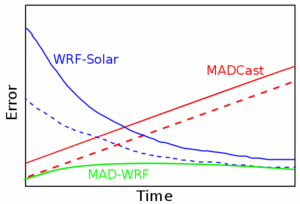MAD-WRF
A solar irradiance nowcasting system to support the Group on Earth Observations (GEO) Vision for Energy
A GEO Vision for Energy (GEO-VENER) goal includes “the availability and long-term acquisition of data from satellite and in-situ instruments and models to make possible the effective deployment, operation and maintenance of renewable energy systems and their integration in the grid.” The challenge for renewable energy systems is managing the high spatial and temporal variability of renewable resources. The adverse effects of this high variability in energy production can be mitigated via accurate predictions of the renewable resources (e.g. solar irradiance).
Short-term predictions of up to a few hours (i.e. nowcasting) of solar irradiance are already being used to manage renewable systems. Nowcasting systems help operators ensure grid stability and power plant performance. Standard nowcasting methodologies include the use of retrievals from earth observing satellites to detect and advance the clouds (e.g. Lee et al. 2017). This methodology faces limitations when clouds grow or decay, or they are anchored to various terrain features. Full cloud processes are better represented in numerical weather prediction (NWP) models. However, nowcasting systems based on NWP models do not always include accurate satellite-based cloud initialization.
To overcome the limitations of current solar irradiance nowcasting systems we are blending a satellite- based initialization system with a NWP-based nowcasting approach to create an improved end-to-end solar irradiance forecast system, called MAD-WRF. The development of MAD-WRF forms part of the National Aeronautics and Space Administration (NASA) Earth Science Division (ESD) efforts to advance specific elements of the GEO Work Programme 2017-2019 through the Applied Science Program (ASP).
MAD-WRF will blend two nowcasting systems. The Multi-sensor Advection Diffusion nowCast (MADCast) version 2 (Xu et al. 2016) assimilates infrared profiles from instruments on board different satellites (GOES, MODIS, AIRS, etc.) using a particle filter to infer the presence of clouds. This three-dimensional (3D) cloud field is subsequently advected and diffused by a modified version of the Weather Research and Forecasting (WRF, Skamarock et al. 2008) NWP model that produces the solar irradiance forecast. The second nowcasting system is based on WRF with extensions for solar energy applications (WRF-Solar®, Jimenez et al. 2016). Our results running both models indicate that MADCast typically produces superior performance than WRF- Solar at the beginning of the simulated period. This is due to the improved satellite-based cloud analysis. However, after an hour or two into the forecast, the improved physics of WRF-Solar® provides the superior solar irradiance forecast. Blending the two systems in MAD-WRF will provide a prediction system with the strengths of both nowcasting methods. Figure 1 shows a conceptual diagram illustrating the performance of MADCast, WRF-Solar® and the expected performance of MAD-WRF. An initial exploration of the viability of MAD-WRF showed promising results (Haupt et al. 2018).
The improved nowcasts from MAD-WRF will help achieve GEO-VENER goals of making possible the effective deployment, operation and maintenance of renewable energy systems and their integration in the grid. MAD-WRF will be publicly available to help achieve GEO-VENER goals beyond this project.
Resources
-
Building the Sun4Cast system: Improvements in solar power forecasting
Description
Haupt, S. E., B. Kosovic, T. Jensen, J. K. Lazo, J. A. Lee, P. A. Jiménez, J. Cowie, G. Wiener, T. C. McCandless, M. Rogers, S. Miller, M. Sengupta, Y. Xie, L. Hinkelman, P. Kalb, and J. Heiser, 2018: Building the Sun4Cast system: Improvements in solar power forecasting. Bull. Amer. Meteor. Soc. 99, 121-135, https://doi.org/10.1175/BAMS-D-16-0221.1.
-
WRF-Solar: Description and clear-sky assessment of an augmented NWP model for solar power predictio
Description
Jiménez, P. A., J. P. Hacker, J. Dudhia, S. E. Haupt, J. A. Ruiz-Arias, C. A. Gueymard, G. Thompson, T. Eidhammer and A. Deng, 2016: WRF-Solar: Description and clear-sky assessment of an augmented NWP model for solar power prediction. Bull. Amer. Meteor. Soc., 97, 1249-1264, https://doi.org/10.1175/BAMS-D-14-00279.1.
-
Solar irradiance nowcasting case studies near Sacramento
Description
Lee, J. A., S. E. Haupt, P. A. Jiménez, M. A. Rogers, S. D. Miller, and T.C. McCandless, 2017: Solar irradiance nowcasting case studies near Sacramento. J. Appl. Meteor. Climatol., 56, 85-108, https://doi.org/10.1175/JAMC-D-16-0183.1.
-
A description of the Advanced Research WRF version 3
Description
Skamarock, W. C., J. B. Klemp, J. Dudhia, D. O. Gill, D. M. Baker, M. G. Duda, X.-Y. Huang, W. Wang, and J. G. Powers, 2008: A description of the Advanced Research WRF version 3. NCAR Tech. Note NCAR/TN-475+STR, 113 pp., https://doi.org/10.5065/D68S4MVH.
-
A method for retrieving clouds with satellite infrared radiances using the particle filter
Description
Xu, D., T. Auligné, G. Descombes, and C. Snyder, 2016: A method for retrieving clouds with satellite infrared radiances using the particle filter. Geosci. Model Dev., 9, 3919-3932, https://doi.org/10.5194/gmd-9-3919-2016.
-
Examining the potential of a random forest derived cloud mask from GOES-R satellites to improve solar irradiance forecasting.
Description
McCandless, T., and P.A. Jimenez, 2020: Examining the potential of a random forest derived cloud mask from GOES-R satellites to improve solar irradiance forecasting. Energies, 13, 1671. Open access article available online at https://www.mdpi.com/1996-1073/13/7/1671
-
Assessment of the GOES-16 clear sky mask product over the Contiguous U.S. using CALIPSO retrievals.
DescriptionJimenez, P.A., 2020: Assessment of the GOES-16 clear sky mask product over the Contiguous U.S. using CALIPSO retrievals. Remote Sens. 2020, 12, 1630. Open access article available online at https://www.mdpi.com/2072-4292/12/10/1630
Contact
Please direct questions/comments about this page to:
Pedro Jimenez Munoz
Proj Scientist III
